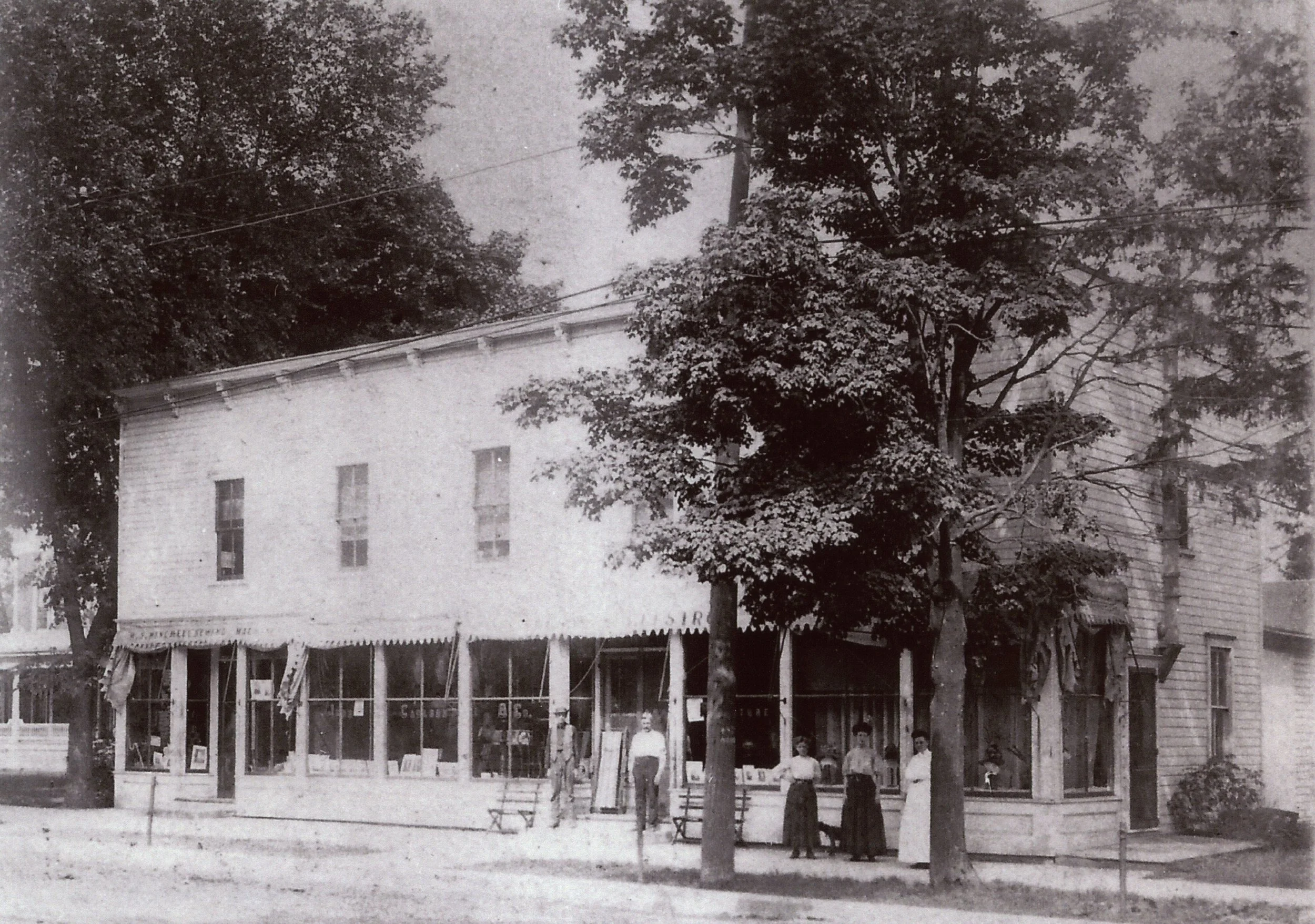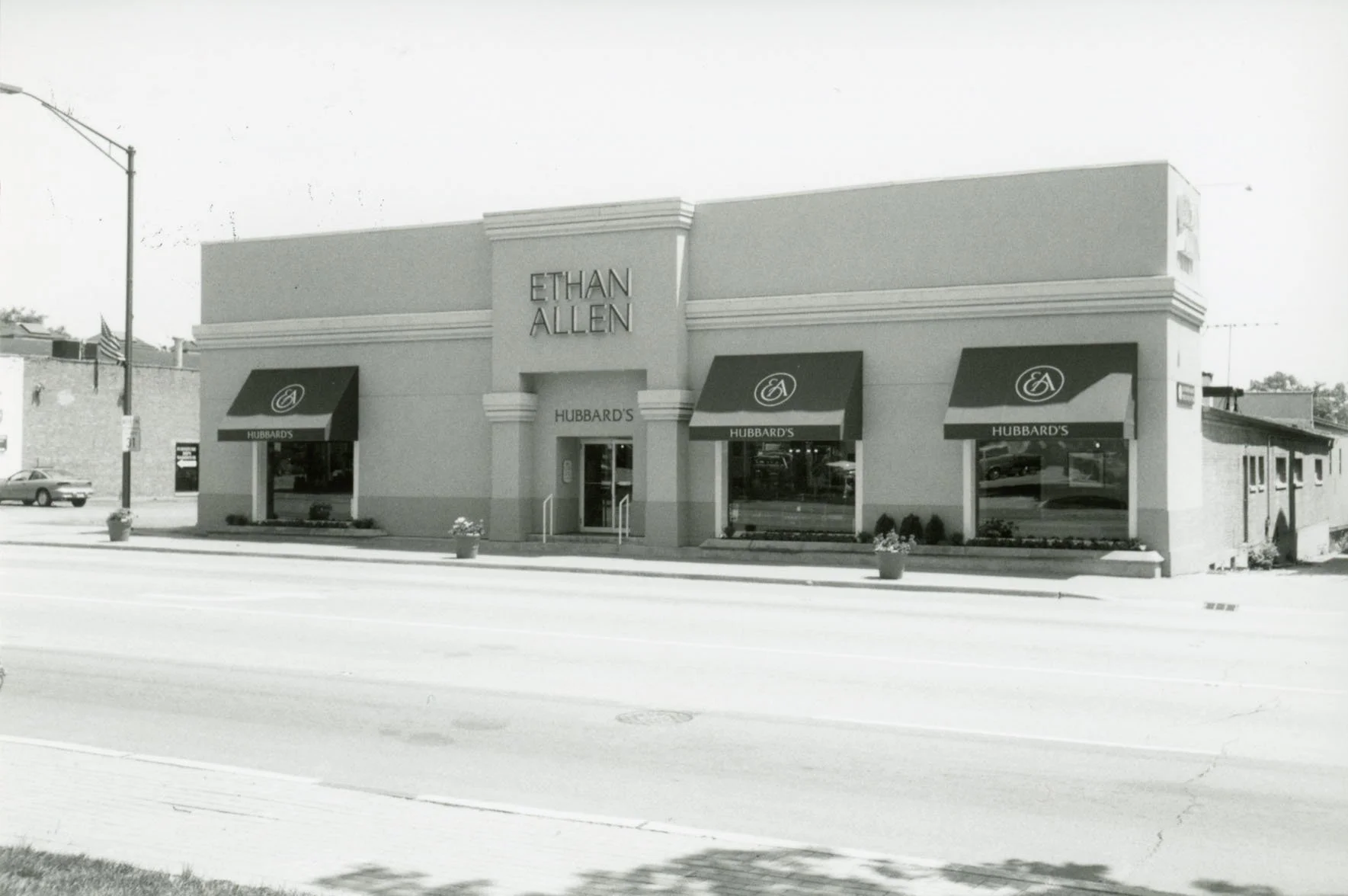Figure 1. Hubbard's Home Furnishings, c. 1950. Photo courtesy of the Batavia Depot Museum.
A fixture of Batavia’s commercial corridor at 16 N. Batavia Ave. for over 100 years, Hubbard’s Home Furnishings is one of the most cobbled-together buildings in the Fox Valley. The former furniture store is actually six different buildings that were merged into one large and frequently-shopped store. One of the additions, for example, was a gymnasium in which the 1912 Batavia High School Basketball State Champions played their home games. Part of the original gym floor is still there!
While the property has been home to a furniture store since 1897, its story begins much earlier.
A TEMPORARY church
A one-story wood-framed church was the first structure built on this property, perhaps as early as 1842 (see Figure 2).[1] The Presbyterian Church of Batavia, which became the Congregational Church of Batavia, acquired the property on August 1, 1842.[2] The church was likely built in the 1840s, but the exact date is unclear.
Figure 2. The single-story wood structure visible to the left of this photo of the Batavia United Methodist Church was built by the Congregational Church in c. 1842. Photo from Images of America: Batavia, by Wynette A. Edwards and Jim Edwards (Mt. Pleasant, SC: Arcadia Publishing, 2000), 98.
For over 50 years, this church served as a temporary place of worship for several congregations while they constructed their own permanent churches.
The Congregational Church moved out when it completed its stone church located at 21 S. Batavia Ave. in 1855.[3] On April 1, 1862, the Catholic Church purchased the property at 16 N. Batavia Ave for Batavia’s Holy Cross Catholic Church.[4] The Catholic Church may have shared this church with the Baptists while each congregation raised money to build their own churches—the First Baptist Church of Batavia at E. Wilson St. and N. Washington Ave. in 1888, recently demolished, and the Holy Cross Catholic Church at E. Wilson St. and N. Van Buren St. in 1897.[5]
Figure 3. Carlson & Co. Store, c. 1900. Photo courtesy of the Batavia Depot Museum.
FURNITURE STORE OPENS
Worship services ended in the little wood-framed church in 1897 when the Catholic Church sold the building for $2,000 to John Benson and John Carlson.[6] Shortly after acquiring the property, Benson and Carlson added a two-story wood structure onto the west and north facades of the church and opened a furniture store (see Figure 3).[7]
In 1910, Gustav “Ed” Hubbard and Charles Johnson bought the property and continued its use as a furniture store, eventually named Hubbard’s Home Furnishings, and later Ethan Allen’s.[8] Tragically, the one-story church portion of the furniture store burned down around 1915, according to the Batavia Depot Museum records, but the two-story addition, which remains today, survived. There is a possibility that remnants of the original 1840s church survived the fire, but that is unlikely.[9] Because of this, the original furniture store would be the two-story, west façade section, now clad with Dryvit that was built in 1897.
A GYMNASIUM ADDED TO A FURNITURE STORE?!
Multiple additions were made to Hubbard’s throughout its 100-year history. The most interesting addition was a former gymnasium that was moved to the property. Around 1900, the Batavia United Methodist Church, directly south of Hubbard’s, built a gymnasium on its property.[10] This gymnasium hosted games from the West Batavia High School basketball team, which won the Boys Basketball State Championship in 1912.[11] Sometime after 1916, Hubbard and Johnson bought the gymnasium and moved it to the rear of their store.[12] Portions of the original gym floor are still visible in that portion of the former furniture store.[13]
Further additions included two one-story buildings, one with a red-brick facade, to the rear of the main building and another south of the gymnasium. An additional two-story building was added to the rear, and a warehouse, which later became “the site of the popular Lemon Shop where some furniture was sold at reduced prices,” on N. Water Street, was purchased.[14]
CHANGES DIMINISH ITS HISTORIC VALUE
Figure 4. Hubbard's Ethan Allen, c. 1990. Photo courtesy of the Batavia Depot Museum.
The basic footprint of the furniture store is the same as it was when all the additions were completed by the 1970s, but there have been significant alterations to exterior materials (see Figures 4). For example, the west façade, which was in the Italianate style with wood siding and several windows, has been covered with Dryvit. The roof of the former gymnasium has been changed to modern asphalt shingles, and the siding is now vinyl.
While each of the additions and alterations is part of Hubbard’s Home Furnishings story, this has caused its historic value to be diminished. One of the key factors that determines whether or not a building is historic is “integrity,” meaning that a building has to have the same or similar look and feel as it did originally. Changes can be made, but if the building does not look substantially the same, it lacks “integrity” and generally is not considered to be historic. Comparing the photos of the building’s storefront, it is clear that it looks nothing like it did originally.
Integrity, while an important factor in determining historic value, is not the ONLY factor. In some cases, alterations are part of its historic significance, or the people associated with the building were important, or a significant event occurred in the building that is deemed of greater importance than its integrity.
FUTURE?
Hubbard’s Home Furnishings was sold to the Batavia United Methodist Church in 2015 and has been vacant since 2019, when Acosta’s consignment moved out. There are many challenges to overcome to make the structures viable for a new tenant, not the least of which is the church’s desire to demolish the building so that it can expand its own historic building.
If the building is lost, hopefully some of what happened there will not be.
Thank you for reading! If this story interested, inspired, or informed you, please consider subscribing to our monthly e-newsletter so more of these stories come right to you!
[1] Jack McKee to Trustees of the Congregational Church of Batavia, Indenture, Deed Book 53, Page 69, August 18, 1857, Kane County Recorder, Geneva, Illinois.
[2] Ibid.
[3] Bill Hall, “Hubbard’s,” edited by Marj Holbrook, The Batavian Historian 54, no. 1 (January 2013), 2.
[4] Denison K. Town to Jas Duggan, Catholic Bishop of Chicago, Ill, Indenture, Deed Book 71, Page 338, April 1, 1862, Kane County Recorder, Geneva, Illinois.
[5] Bill Hall, “Hubbard’s,” edited by Marj Holbrook, The Batavian Historian 54, no. 1 (January 2013), 2.
[6] Frank P. Conde, et. al. to John Benson and John Carlson, Warranty Deed, Deed Book 374, Pages 133-134, July 14, 1897, Kane County Recorder, Geneva, Illinois.
[7] Sanborn Fire Insurance Map from Batavia, Kane County, Illinois, Sanborn Map Company, October 1891, map, https://www.loc.gov/resource/g4104bm.g017241891/?sp=4&st=image; Sanborn Fire Insurance Map from Batavia, Kane County, Illinois, Sanborn Map Company, December 1897, map, https://www.loc.gov/item/sanborn01724_003/.
[8] Bill Hall, “Hubbard’s,” edited by Marj Holbrook, The Batavian Historian 54, no. 1 (January 2013), 2; John Carlson and Anna Carlson to Gustaf E. Hubbard and Charles Johnson, Warranty Deed, Deed Book 520, Page 292, September 29, 1910, Kane County Recorder, Geneva, Illinois.
[9] Bill Hall, “Hubbard’s,” edited by Marj Holbrook, The Batavian Historian 54, no. 1 (January 2013), 2; Kate Garrett to Al Watts, email, RE: 16 N. Batavia Ave., September 15, 2025.
[10] Sanborn Fire Insurance Map from Batavia, Kane County, Illinois, Sanborn Map Company, December 1907, map, https://www.loc.gov/item/sanborn01724_004/.
[11] “Illinois Boys State Title Winners,” Illinois High School Basketball, accessed September 23, 2025, https://illinois-basketball.com/championships/boys-state-winners/.
[12] Bill Hall, “Basketball in the Hubbard’s Building,” edited by Marj Holbrook, The Batavian Historian 54, no. 1 (January 2013), 5; Sanborn Fire Insurance Map from Batavia, Kane County, Illinois, Sanborn Map Company, August 1916, map, https://www.loc.gov/item/sanborn01724_005/.
[13] Kate Garrett to Al Watts, email, RE: 16 N. Batavia Ave., September 15, 2025.
[14] Bill Hall, “Hubbard’s,” edited by Marj Holbrook, The Batavian Historian 54, no. 1 (January 2013), 4.




